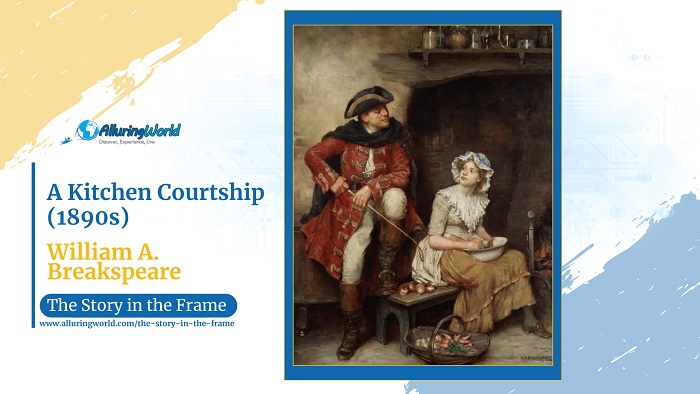Painted in the late 19th century, A Kitchen Courtship by British artist William A. Breakspeare is a charming and intimate genre scene that reflects the artist’s fascination with storytelling through everyday domestic life. Breakspeare, associated with the Birmingham School and the Pre-Raphaelite movement, often painted romanticized depictions of interiors, conversations, and moments of gentle humor or tenderness. This painting exemplifies his ability to capture subtle human interactions within a carefully detailed setting.
About the Painter:
William A. Breakspeare (1855–1914) was a British painter known for his genre paintings, portraits, and scenes influenced by both the Pre-Raphaelites and continental academic traditions. He trained in Birmingham, where he became associated with the city’s group of artists who valued craftsmanship, narrative painting, and a return to fine detail. Breakspeare later exhibited at the Royal Academy and other major venues, earning recognition for his ability to blend historical or romantic themes with a sense of intimacy. His works often depict lighthearted domestic scenes, emphasizing emotion and atmosphere.
Inspiration and Reasons Behind the Painting:
Breakspeare painted during a time when Victorian audiences were particularly fond of genre paintings that combined moral undertones with sentimentality and charm. A Kitchen Courtship reflects this cultural taste, presenting a scene of budding romance in a humble domestic setting. Kitchens were traditionally associated with warmth, work, and the heart of the home, making them an ideal stage for depicting affection in its simplest and most sincere form. The painting likely appealed to Victorian sensibilities by portraying romance not in grand or dramatic terms but in the context of everyday life.
What is Depicted in the Painting:
The composition centers on a young man and woman in a kitchen, engaged in a conversation that hints at courtship. The man leans slightly toward the woman, perhaps offering a compliment or jest, while she responds with a mixture of coyness and amusement. Surrounding them are the details of the kitchen—pots, utensils, and rustic furnishings—which frame the encounter in a setting of warmth and simplicity. The figures’ gestures and expressions tell the story, suggesting affection, modesty, and the beginnings of intimacy. The overall mood is light, tender, and infused with gentle humor.
Colors and Techniques:
Breakspeare’s palette in A Kitchen Courtship is warm and natural, dominated by earthy tones that highlight the rustic charm of the kitchen interior. His attention to detail in the depiction of household objects enhances the authenticity of the scene, while the soft handling of light gives it a cozy, inviting atmosphere. The smooth brushwork, precise contours, and lifelike rendering of faces reflect his academic training, while the narrative focus connects with the storytelling tradition of genre painting.
Conclusion:
A Kitchen Courtship is a delightful example of William A. Breakspeare’s ability to turn ordinary domestic scenes into tender narratives filled with warmth and humanity. Through careful detail, expressive gestures, and an inviting atmosphere, the painting captures the timeless theme of love blooming in everyday life. It reflects both the Victorian appreciation for sentimentality and the artist’s talent for imbuing simple interactions with poetic significance, ensuring its enduring charm for modern audiences.

